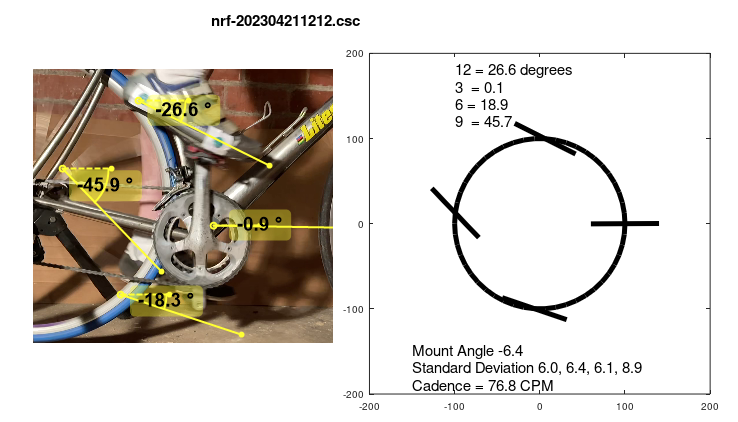Q: My seat position is fine…what else can this thing do?
After group rides my friends and I often talk about the ride. Having the ride as data lets you see it in a different way.
This section of data represents some of the hills on what we call the St. Rose loop. Each circle is an individual pedal stroke. Gaps indicate coasting. Where the ascents and descents occur depends on how you gear and spin. These data could be used to instruct how to better adjust cadence on hill climbs. (Note: Back pedaling briefly creates a data marker – detectable by an analysis program – which can be used to indicate the beginning of each climb.)
Cross correlation could be used to identify issues that might not show up in average summaries. Pictured here is a view that might show pedal angle efficiency issues related to pedaling speed. Another correlation might be total pedal angle and cadence (which appears to show a relationship between cadence and ride intensity).
The ride data can tell when the rider is standing, sprinting, standing and sprinting. Pictured here is the accelerometer pitch signal during 4 periods of ten pedal strokes both standing and then sitting. A similar signal disturbance can be seen in the pedal angle smoothness/efficiency data. Taken together they provide high confidence stand detection.
A company named Magene makes a bicycle cadence sensor that doubles as a speed sensor. I found this idea relatively easy to duplicate. I used a rubber band to attach my motion sensor to the rear hub of my stationary bike.
My bicycle sits on top of a Kinetic by Kurt stationary trainer. The trainer resistance is calibrated to represent a known range of watts based on speed. With this information I was able to calculate both speed and power.
Measuring the pedal, along with speed and power might offer some unique opportunities for real-time analysis.
In addition to biking, I cross train by running. I have a MilestonePod to measure aspects of my run. Zwift purchased this technology and now my device no longer works. I miss my MilestonePod, so I placed my sensor on my shoe. First walking, and then running at different speeds I used a correlation analysis program to find an equation that matched the motion data with speed.
Although the equation closely matched my speed, it is only on a treadmill and the run was at a steady stride length. Running on more different types of terrain, and possibly wearing different running shoes would be needed to develop a more accurate system. With a little work I may be able to create my own MilestonePod.
During winter months riding indoors on the trainer I listen to a song playlist – not for the music so much as the cadence. I pedal to the beat of the songs. This lets me complete the workout pace I want, while thinking about other things. Currently the music is on an MP3 player. Now that my phone is monitoring my ride, it could play the songs and count my pedal strokes. As part of an overall ride score, I might lose points if I don’t keep pace with the music. (The music might even slow down if I’m not riding fast enough.)
I believe history shows that inventors do not always find the best uses of their ideas. I suspect this may be the case here as well. -Bryan

Comments
Post a Comment